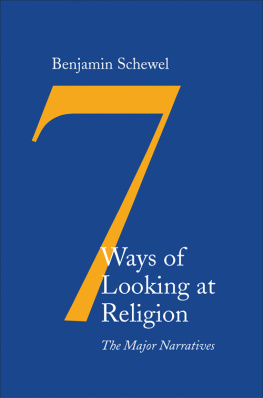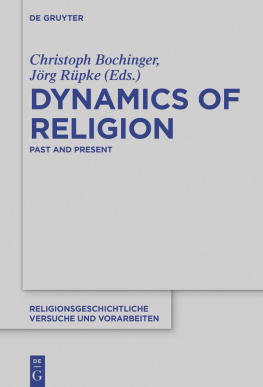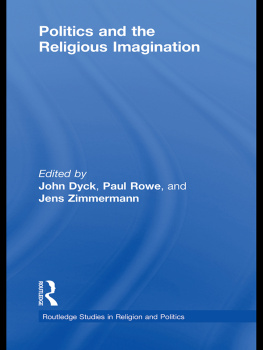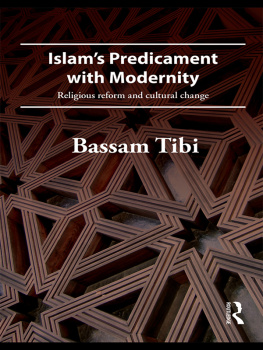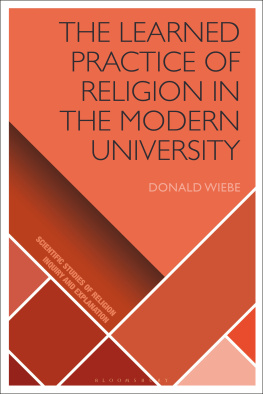SEVEN WAYS OF LOOKING AT RELIGION

Published with assistance from the foundation established
in memory of Amasa Stone Mather of the Class of 1907,
Yale College.
Copyright 2017 by Yale University.
All rights reserved.
This book may not be reproduced, in whole or in part, including
illustrations, in any form (beyond that copying permitted by Sections
107 and 108 of the U.S. Copyright Law and except by reviewers for
the public press), without written permission from the publishers.
Yale University Press books may be purchased in quantity for
educational, business, or promotional use. For information, please
e-mail
(U.K. office).
Set in Janson type by IDS Infotech Ltd.
Printed in the United States of America.
Library of Congress Control Number: 2016963571
ISBN 9780300218473 (hardcover : alk. paper)
A catalogue record for this book is available from the British
Library.
This paper meets the requirements of ANSI/NISO Z39.481992
(Permanence of Paper).
10 9 8 7 6 5 4 3 2 1
For Keri
Contents
Acknowledgments
T HIS IS A BOOK I always wanted to read but could never find. So I decided to write it, and it took me nearly a decade to figure out what to say. I therefore must first and foremost thank my teachers Peter Ochs, Kevin Hart, and William Desmond, without whom I would have never been able to imagine, much less complete, this book.
My research has benefited from regular conversations with numerous friends and colleagues. Many of the concepts and ideas I present in the following pages arose through my ongoing discussions with Gerald Filson and Christopher Schwartz. I must thank Farzam Arbab and Sona Farid-Arbab for helping me think about the methodological aspects of this work. I am also grateful to the Faculty of Divinity at the University of Cambridge, where I worked on this project as a visiting graduate student during the 20132014 academic year, and to the Institute for Advanced Studies in Culture at the University of Virginia, where I had the pleasure of revising this manuscript during the 20142015 academic year. In particular, I am indebted to Charles Mathewes for organizing an all-day workshop on this book at the institute and for providing thoughtful feedback on the entire manuscript.
Finally, I want to thank my parents, Michael Schewel and Priscilla Burbank, and my wife, Kerilyn Schewel, for their ongoing efforts to help me bring this book to completion. To Kerilyn in particular, let me say that none of this would have been possible without your tireless love and constant support.
Introduction
W ESTERN INTELLECTUALS HAVE LONG theorized that religion would undergo a process of marginalization and decline as the forces of modernity advanced. Indeed, this framework of secularization is one of the few theories to have achieved a truly paradigmatic status within the modern social sciences. Secularization theory reached its peak influence during the middle decades of the twentieth century, when global affairs seemed to corroborate its basic claims. Like dying supernovae, three analysts explain, every major religion on every continent seemed to be rapidly losing its influence on politics, economics, and culture. It was with these dynamics in mind that sociologist Peter Berger announced to readers of the New York Times in 1968 that by the 21st century, religious believers are likely to be found only in small sects, huddled together to resist a worldwide secular culture.
Yet secularization theory has fallen on hard times in the intervening years. The main cause of this disruption has been the so-called resurgence of religion in public settings throughout the world. Examples include the Six-Day War between Israel and Egypt, the Iranian Revolution, Hindu nationalism in India, Buddhist nationalism in Sri Lanka, Catholicisms role in overthrowing communism in Eastern Europe, prominent movements of religiously inspired nonviolent civil disobedience, the rise of evangelical conservatism in the United States, the appearance of
Nevertheless, it is not yet clear what kind of narrative we should be telling instead. Certainly, scholars generally agree that religion has evolved from its tribal beginnings through the so-called archaic, axial, and medieval periods, up through modernity, and into the current global age. But it is by no means clear what dynamics have driven this process forward. Perhaps secularization theory was basically true and the contemporary resurgence of religion is only a last-ditch effort on the part of religious believers to halt their own demise. Or perhaps religion has been historically developing and improving, such that each stage of religious history, including the current one, is somehow better or more complex than what came before. Alternatively, maybe religion developed and improved until a certain point but has since been losing its force. Or religion might be neither developing nor declining, but rather transforming in a more neutral way. It could even be that religion never existed at all, but has simply been constructed in the modern West and then exported throughout the world. Well-regarded thinkers are today actively arguing for each of these perspectives.
The persistence of narrative plurality may seem strange to those who imagine that disciplined empirical research would have, by now, proven which narrative is best. Unfortunately, this has not been the case. In some places religion is declining. In others it is resurging. In others still, religion remains just as influential as it has been for centuries before, albeit now in a distinctly modern form. How, then, should we go about choosing between the various narratives that are currently being advanced?
Whatever solution we may ultimately adopt, we should begin by making sure that all the options are clearly understood. How many major narratives of religious history exist? By whom are they employed? How do they each operate? What stages of religious history do they describe? How do they characterize contemporary dynamics of religious change? What future trajectories do they envision? The goal of this book is to answer these questions.
Seven Narratives
My basic claim is that the contemporary academic discourse on religion pivots around seven narrative frameworks, which I describe as the (1) subtraction, (2) renewal, (3) transsecular, (4) postnaturalist, (5) construct, (6) perennial, and (7) developmental narratives. I will briefly explain what I mean by each term before justifying my choice of these specific narratives:
(1) The subtraction narrative is based on the idea that religion is a way of coping with the conditions of ignorance, powerlessness, and cultural passivity that plagued early human existence. Following this rationale, as humanitys knowledge, power, and pace of cultural change advance, which is evidently happening in the modern world, we should become less and less religious. Some subtraction narratives claim that this process of religious decline is necessary and inevitable. Classical secularization theory thus fits neatly within the subtraction narrative framework. Yet other subtraction narratives argue that processes of religious decline can be slowed or halted if humanity strays from the proper course, the contemporary resurgence of religion being a prime example. And others still seek to reframe the growing prominence of religious actors as part of a broader process of religious decline, perhaps in a desperate attempt to halt the rising tide of secularization, or as an inconsequential trend within a global marketplace of ideas that has already become largely irreligious.
(2) The renewal narrative roots the problems of modernity in humanitys departure from a religious truth that was better known to inhabitants of an earlier epoch. Although different renewal narratives highlight different truths, they all agree that humanity can solve its current problems only by reengaging the relevant truth today. From this perspective, the rising public influence of religion is often interpreted as a sign of humanitys dawning desire to find its However, we also find more sophisticated visions of renewal among, say, Catholics who view Western modernity as a hasty reaction against the Church and orthodox Christian teaching, or Hindus who believe that modern capitalistic society has blinded us to the spiritual truths that were outlined in the Vedas long ago.
Next page
